User:Neuroforever
Who am I?
[edit]
Dr. Osama Shukir Muhammed Amin FRCP(Edinburgh), FRCP(Glasgow), FRCP(Ireland), FRCP(London), FACP, FCCP, FAHA, FRSA. I'm very interested in photography; I take photos of archaeological and ancient sites as well as artifacts housed in museums. But, I'm an associate professor of neurology, consultant neurologist, and former director of the Neurology Board, Sulaymaniyah!
My article and photos about the newly discovered tablet V of the Epic of Gilgamesh in the Ancient History Encyclopedia, in September 2015, drew the attention of the World to this hidden gem.
My main focus is Mesopotamian history; I contributed quite a few high-quality images of Mesopotamian artifacts, ancient Mesopotamian cities, Paleolithic caves in Iraq, and rock reliefs. I've published many articles on several websites about Mesopotamia. I'm also interested in ancient Egypt! But, I have contributed to almost all the World's civilizations.
I use Nikon D90, Nikon D610, and Nikon D750 cameras, with several lenses.
If you need to use any image from my Wikimedia Commons uploads, please feel free, but remember, you have to credit me properly and in full, as all of my images on Wikimedia Commons carry a "CC BY-SA 4.0 international" license. I don't grant permission to use my images for commercial purposes. To credit me, use the following formula:
Photo credit: Osama Shukir Muhammed Amin FRCP(Glasg), CC BY-SA 4.0, via Wikimedia Commons (insert the URL of the image here).
My Favorite Collection
[edit]The Iraq Museum in Baghdad displays a large number of statuettes (including fragments and heads) unearthed from the Diyala Region (Khafajah, Tell Asmar, and Tell Agbrab). The Sulaymaniyah (Slemani) Museum also houses 5 statuettes (given as a permanent load from the Iraq Museum in 1961 CE). Here you can find all of them, on display ones (including Tell Asmar Hoard and Nintu Temple Hoard). Several appear in many publications of the Oriental Institute of the University of Chicago; the latter did the Diyala Region/Valley excavations in the 1930s. However, many I couldn't find in any publication (book, report, or article), except one (in an article by Lamia al-Gailani in 1972 CE in the Journal Iraq). Therefore, they might well have been confiscated or donated to the Museum. If anyone has information (provenance) about these statuettes, please contact me. All of them were shot with My Nikon D750 camera.
-
Sumerian male worshiper from Diyala Region, Iraq
-
Sumerian male worshiper from Diyala Province, Iraq
-
Sumerian male worshiper from Diyala, Iraq
-
Female worshiper from Diyala Province, Iraq
-
Female worshiper from Diyala Region, Iraq
-
Female worshiper from Diyala, Iraq
-
Male head from Shara Temple, Tell Agrab, Iraq
-
Male Statuette from Nintu Temple, Khafajah, Iraq
-
Male Statuette from Sin Temple IX, Khafajah, Iraq
-
Male statuette, Nintu Temple VI, Khafajah, Iraq
-
Female worshiper from Khafajah, 4th season, Iraq
-
Female statuette, fragment, from Tell Agrab, Iraq
-
Seated male figure from the hoard of Nintu Temple V at Khafajah
-
Seated male statue from the Temple of Sin at Khafajah
-
Statue from Nintu Temple VI at Khafajah
-
Male statue from Hoard in Nintu Temple V, Khafajah
-
Statue from the hoard of Nintu Temple V at Khafajah
-
Male statue from Shara Temple, Tell Agrab
-
Head of a Sumerian woman from Tell Agrab, Shara Temple
-
Statue of a Sumerian seated worshiper from Tell Asmar
-
Sumerian Status from Tell Asmar, part of the Tell Asmar Hoard
-
Statue from Khafajah
-
Statue from Khafajah, female worshiper
-
State from the Tell Asmar, Iraq Museum
-
Statue from Khafajah, Iraq Museum
-
Sumerian Statues from Eshnunna and Khafajah of Diyala region, Iraq Museum
-
Statue of male worshipper from Tell Asmar
-
Statue from Tell Asmar
-
Sumerian worshiper from Khafajah, Iraq Museum
-
Sumerian Worshippers from Sumer, Southern Mesopotamia, Iraq. Early Dynastic Period, 2900-2300 BCE. The Sulaymaniyah Museum, Iraq
-
Three Sumerian statues, Early Dynastic Period, 2900-2350 BCE, from Khafajah, Iraq. The Sulaymaniyah Museum
-
Head of a statue from Tell Asmar, excavated by the Oriental Institute in 1933. The Sulaymaniyah Museum
-
Headless statue of a Sumerian man, from Khafajah, Early Dynastic Period, 2900-2350 BCE. The Sulaymaniyah Museum
-
Statuette of a Sumerian male from Diyala Region, Mesopotamia, Iraq
-
Statuette of a seated Sumerian female worshiper from Diyala Region, Iraq
-
Headless statuette of a Sumerian male worshiper from Diyala Region, Iraq
-
Statuette of a Sumerian female worshiper from Diyala Region, Iraq, face dwindled
-
Sumerian worshiper with a dagger, from Diyala Region, Iraq
-
Upper part of a statuette of a male from Diyala Region, Iraq
-
Fragment of a torso of a Sumerian female worshiper, from Diyala Region, Iraq
-
Headless statuette of a Sumerian female worshiper from Diyala Region, Iraq
-
Upper part of a statuette of a Sumerian male from Diyala Region, Iraq
-
Headless statuette of a Sumerian male worshiper from Diyala Region, Mesopotamia, Iraq
-
Statuette of a Sumerian female worshiper from Diyala Region or Ur, Iraq
-
Statuette of a Sumerian male from Diyala Region, Mesopotamia, Iraq, small one
-
Headless statuette of a bearded Sumerian male from Diyala Region, Iraq
-
Female head from Khafajah, Diyala Region, Iraq
-
Head of a Sumerian male from Khafajah, Diyala Region, Iraq
-
Head of a Sumerian male from Khafajah, Diyala, Iraq
Gallery
[edit]Some images of mine:
-
Naram-Sin Rock Relief at Darband-i-Gawr, Qaradagh Mountain, Sulaymaniyah. Iraq
-
Tablet V of the Epic of Gilgamesh
-
Cuneiform inscriptions, Stela of Iddi-Sin, king of Simurrum.
-
An Inscribed stand's head, early dynastic period.
-
Paikuli Tower
-
Room 17, the Nereid Monument at the British Museum, London. An actress performs a play in front of the monument
-
An actress performing a play. She wears a laurel wreath and stands in front of a statue of a woman from the Mausoleum at Halicarnassus. Room 21, The British Museum, London
-
Earrings from Shulgi
-
Tablet of Shulgi
-
Bust of Michael Collins at Merrion Square Park, Dublin, Ireland.]]
-
Sumerian Worshiper
-
The Assyrian king Shalmaneser III receives tribute from Sua, king of Gilzanu, The Black Obelisk.
-
Cylinder of Nabonidus from the temple of God Sin at UR, Mesopotamia. .]]
-
One of the rooms at the Petrie Museum of Egyptian Archaeology, London. The so-called "mummy portraits" are seen on the left, within their displaying case
-
The facade of Sir John Soane's Museum, note the queue. You should switch off your mobile phone. No photography is allowed. You should put your hand bag, camera, etc within a plastic bag at the entry of the building
-
Statue of The Thinker, 1880 CE.
-
General view of one of the halls. Kelvingrove Art Gallery and Museum, Glasgow, Scotland
-
Marble busts of Hadrian (left, 117-138 CE, probably from Rome) and Antinous (right, 130-138 CE, from Rome). Antinous was Hadrian's lover. He met Hadrian in 120s CE and died in the Nile, Egypt, in 130 CE. The British Museum, London
-
Henri IV on Horseback Trampling his Enemy. Bronze, circa 1615-1620 CE. From France, probably Paris. The Victoria and Albert Museum, London
-
Bust of Josephine Bonaparte, c. 1808 CE. Marble, from Paris, France. By Joseph Chinard. Bequeathed by Miss F.H. Spiers. The Victoria and Albert Museum, London
-
Limestone trial piece of a private person. Head of a princess on the reverse. Reign of Akhenaten. From Amarna, Egypt. Petrie Museum of Egyptian Archaeology, UCL, London
-
Upper part of a statuette of an Egyptian man and his wife. 18th Dynasty. From Egypt. From the Amelia Edwards Collection. Now housed in the Petrie Museum of Egyptian Archaeology, London
-
Carved wooden figure of Job. Probably from Germany, 1750-1850 CE. The Wellcome Collection, London
-
The Royal College of Physicians and Surgeons of Glasgow, 232-242 St. Vincent Street, Glasgow, Scotland




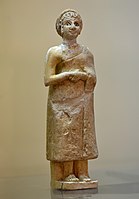



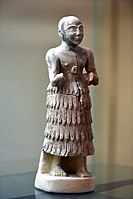








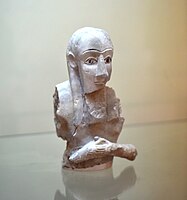



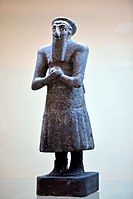



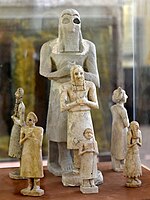



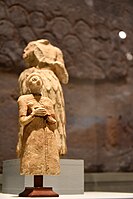
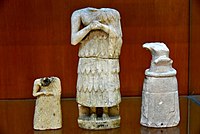





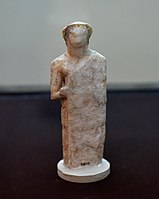
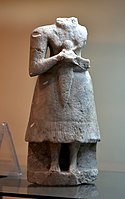

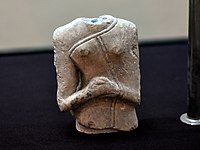






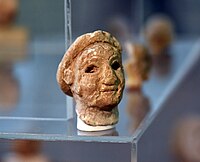

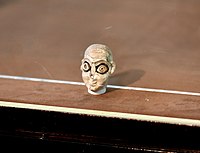









![Bust of Michael Collins at Merrion Square Park, Dublin, Ireland.]]](https://upload.wikimedia.org/wikipedia/commons/thumb/b/b9/Bust_of_Michael_Collins_at_Merrion_Square_Park%2C_Dublin%2C_Ireland..JPG/120px-Bust_of_Michael_Collins_at_Merrion_Square_Park%2C_Dublin%2C_Ireland..JPG)


![Cylinder of Nabonidus from the temple of God Sin at UR, Mesopotamia. .]]](https://upload.wikimedia.org/wikipedia/commons/thumb/5/5f/Cylinder_of_Nabonidus_from_the_temple_of_God_Sin_at_UR%2C_Mesopotamia._..JPG/120px-Cylinder_of_Nabonidus_from_the_temple_of_God_Sin_at_UR%2C_Mesopotamia._..JPG)










